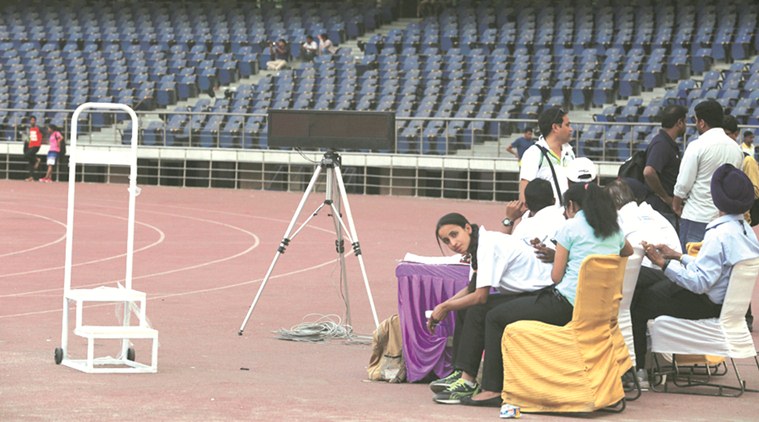 Power failure at the Jawaharlal Nehru Stadium resulted in electronic timings being unavailable for track events. (Express Photo By Amit Mehra)
Power failure at the Jawaharlal Nehru Stadium resulted in electronic timings being unavailable for track events. (Express Photo By Amit Mehra)
The Indian Grand Prix concluded in farcical circumstances on Sunday as a power failure at the Jawaharlal Nehru Stadium resulted in electronic timings being unavailable for track events. While track officials recorded race timings manually, none of the times recorded can be considered for records or for qualification for the Olympics. In addition, the power failure meant that the wind gauge system, another standard requirement for timings to be considered official, too was not functional. The Indian GP, being the first domestic athletics event of the season, was expected to serve as a platform for qualifying for the Rio Games.
Officials present passed the buck. The Athletics Federation of India said the local Delhi State Federation had to answer for the lapse. The Delhi federation in turn said it was the fault of the Sports Authority of India. “We paid Sports Authority of India Rs 1.15 lakh to book the JLN Stadium and outside practice track area for the Indian GP and for Federation Cup (to be held from April 28-30). We also paid Rs 15,000 for security purposes. But to our surprise we found 15 minutes before the start of the meet that there is no electricity at the stadium,” a Delhi Athletics Association official said.
“We contacted the SAI officials and stadium administrator and we were told that there was fire on the transformer and fire brigade was called. But we asked him about the back-up power supply and we could have paid for the cost of diesel to be used for the back-up power supply. It was a really sad situation for the athletes,” the official added.
Compounding the error was the fact that, based on hand timings, four athletes appeared to have set national records and two might have qualified for the Rio Games if the hand timing of their races would have been confirmed by photo-finish equipment.
Amiya Kumar Mallick was clocked at having run the 100m in 10.09 seconds. This would have shattered the national record of 10.30 seconds and would have been faster than the Olympic qualification standard of 10.16 seconds. Srabani Nanda won the women’s 100m in 11.23 seconds as against the 16-year-old national record of 11.38seconds. Mohammed Anas was timed as having run the men’s 400m in 45.41 seconds which would have been quicker than KM Binu’s record of 45.48 set at the Athens Olympics. In the women’s 3000m, L Suriya was clocked at 9.04.45 seconds, nearly two seconds faster than Molly Chacko’s record of 9.06.42 seconds set at the 1994 Asian Games. If Mallick and Nanda’s timing had been made official, they would have also qualified for the Olympics (men’s 100m standard 10.16 seconds, women’s 100m standard 11. 32 seconds).
“Its disappointing because I know I had run a quick time. But it will not count for anything because the electronic timing was not working. I will have to return and give a similar performance at the Federation Cup next week (April 28). I hope to do as well or even better,” said the 24-year-old Mallick.
Lack of accuracy in hand timing was another issue for athletes. With electronic timing, the clock is started the moment the gun is fired and stops the moment the athlete touches the finish line. With hand timing, the operator starts watch a fraction late as he waits for the gunshot and stops the clock a fraction early, as he anticipates the runner reaching the finish line. A combination of the two errors results in the manual timing always appearing faster than electronic timing. A common rule of thumb for track and field statisticians is to add 0.24 to the manually recorded time in 100 and 200m events and 0.14 for events above 400m.
This seems to put the impressive times recorded into better perspective. Mallick’s previous best in the 100m was 10. 51 seconds while if the hand held timing were taken at face value Anas cut more than a second off his previous best timing of 46.66 seconds. This, however, doesn’t take anything away from Suriya’s mark in the 3000m – which, however, isn’t an event at the Rio Games.
The lack of electronic timing wasn’t the only flub committed by organisers. One of the standard corrections made when recording manual timing is to round of the final hundredth of a second to the nearest tenth owing to its inaccuracy. Race results were, however, published down to the hundredth degree. As such Mallick’s 100m timing should have been 10.1 seconds, that of Nanda 11. 3 seconds and Anas’ mark 45.5 seconds.
Comments